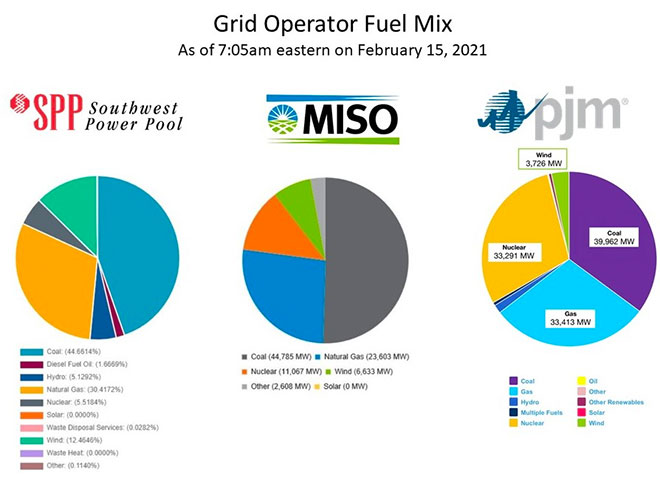Another Reminder of the Under-Appreciated Role of the Coal Fleet in Keeping the Lights On
This article has been reproduced from americaspower.org
By America’s Power
February 16, 2021
As ice storms and record low temperatures gripped many states over the past several days, grid operators struggled to meet soaring electricity demand and were forced to curtail power to millions of customers.[i] Although we will certainly learn more about these events in the coming days, we do know that frozen wind turbines and limited natural gas supplies left much of the generating capacity in these regions unable to provide much-needed electricity. This is an unfortunate reminder of the importance of fuel diversity and the role the nation’s coal fleet still serves in supporting a reliable and affordable electric grid.
Historic winter storms across a large part of the nation have created power emergencies for several major grid operators. MISO, SPP, and ERCOT have all issued warnings to power customers and declared conservation measures in an all-out effort to keep the lights and heat on in homes and businesses.[ii]
In a February 14 press release, ERCOT President and CEO Bill Magness said:
“We are experiencing record-breaking electric demand due to the extreme cold temperatures that have gripped Texas. At the same time, we are dealing with higher-than-normal generation outages due to frozen wind turbines and limited natural gas supplies available to generating units. We are asking Texans to take some simple, safe steps to lower their energy use during this time.”[iii]
ERCOT – the Electric Reliability Council of Texas – manages electric power for 26 million Texas customers, about 90% of the state’s electric load.[iv] On February 15 they were forced to declare an EEA 3 energy emergency alert, instituting rotating power outages to reduce the demand on the electric system.[v] On Monday morning, many customers were left in the dark for hours.
The Midcontinent Independent System Operator (MISO)[vi], which manages the grid across 15 U.S. states and the Canadian province Manitoba, was also forced to announce emergency actions in their South Region [vii], creating periodic power outages for Texas customers. They indicated the severe weather had contributed to the loss of generation and transmission capacity.
The Southwest Power Pool (SPP)[viii], manager of the grid and wholesale power market for 17 states spanning the central U.S., was similarly impacted. SPP issued a level 3 energy emergency as energy reserves fell below the required minimum, marking the first time they had ever had to call for controlled interruptions of service. In one SPP area, utility companies reported that part of the problem was a limited supply of natural gas due to frozen gas wells in the southwest U.S.[ix]
Fortunately, even with the growth of intermittent resources like wind generation in these markets, all three of these grid operators still were able to call upon the coal units in their region to make up for the loss of wind generation in the cold. In much of the country, in the morning of February 15th, coal was providing the majority of the power generation (charts below are from SPP, MISO and PJM respectively). Without coal, the situation would be much worse as wind and solar generation were negatively impacted by the winter weather conditions.

In addition to its reliability, coal also guards against the energy cost increases that can be triggered by extreme weather events. As of Monday, February 15, ERCOT electricity prices jumped to $9,000 per megawatt-hour, the maximum price allowable in the ERCOT system, which is 450 times the 2020 average market price of $20 per MWh.[x]
Like the rolling blackouts California experienced during last summer’s heat wave, the blackouts and restrictions now caused by a winter storm illustrate how fragile the grid becomes when it over-relies on renewables or natural gas. An “all-of-the-above” energy strategy is more than just a catchy slogan in times like these; it is a necessity for people who depend on a steady supply of affordable electricity. Without electricity, our modern lives come to a screeching halt, with serious, sometimes even life threatening, consequences.
The reliability coal brings to the grid should be top of mind when state and federal government, and grid operators, plan changes in power-generation fuel mixes. Overly aggressive targets for removing fossil fuels from the generation mix and increasing the use of intermittent renewable sources can put consumers at risk for increased energy costs or the loss of electricity.
The grid is in the midst of a transition, everyone understands that. But, as current events show, we must also understand that trying to force that transition to happen too rapidly by abandoning the coal fleet would be a costly and dangerous error. We look forward to working with policymakers as they closely examine the root causes of the issues that led to the blackouts in Texas and further tested the reliability of the grid elsewhere.
